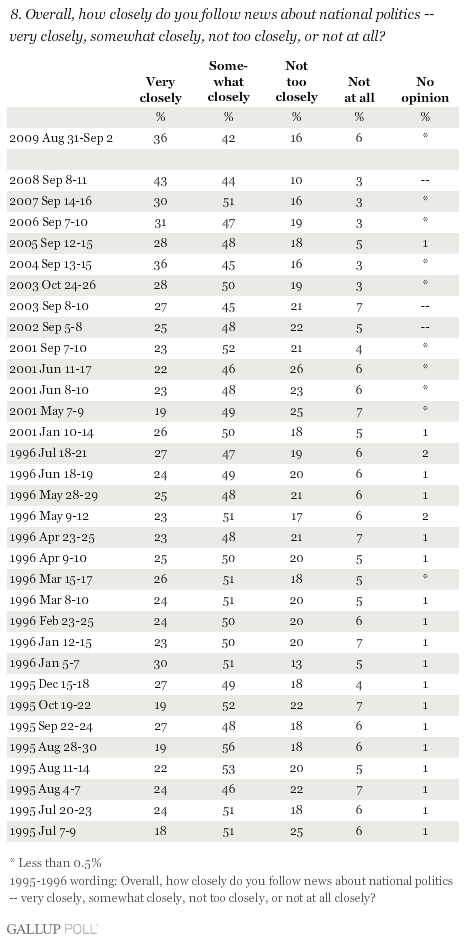PRINCETON, NJ -- Americans are paying closer attention to political news today than in any year without a presidential election since Gallup began regularly tracking this measure in 2001. The 36% of Americans who today say they follow news about national politics "very closely" is down from the record-high 43% Gallup found in September 2008, but matches the level found in September 2004 -- two polls conducted during presidential election years.
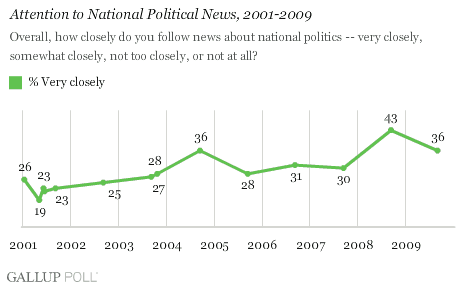
The previous high for a year without a presidential election was 31% in 2006 -- a midterm election year. The previous high for a year without a national election was 30%, in 2007.
"Since 2001, Republicans have typically reported paying closer attention to political news than have Democrats, and that holds today."
Apart from the quadrennial spike in news attention around presidential elections, Americans' focus on political news has gradually increased since 2001, when the percentage paying very close attention averaged 23%. (A Jan. 10-14, 2001, Gallup survey found 26% paying this level of attention, most likely because of the saturation news coverage of the 2000 presidential election and the concluding days of President Bill Clinton's administration. All other measures that year found no more than 23% closely following the news.)
The American public is generally an attentive group when it comes to national politics. In addition to the 36% who follow political news very closely, 42% say they follow it somewhat closely. Very few report paying no attention to political news, a finding consistent with Gallup's polling on this over the past decade, as well as in earlier measurements from 1995 and 1996. (See full trends in table at end of this report.)
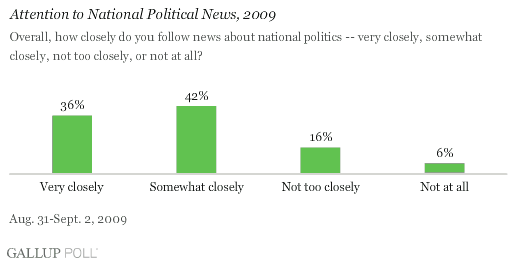
Republicans and Independents More Plugged In Than Democrats
This year's survey, conducted Aug. 31-Sept. 2, finds Republicans and independents paying closer attention to the news than are Democrats. However, taking into account the higher level of little or no attention among independents, Republicans are the most attentive.
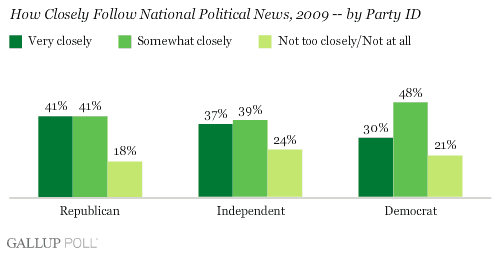
Since 2001, Republicans have typically reported paying closer attention to political news than have Democrats, and that holds today. Most often, Democrats and independents report similar levels of "very close" attention, except in the last two presidential election years, when Democrats' attention surged to roughly match Republicans'.
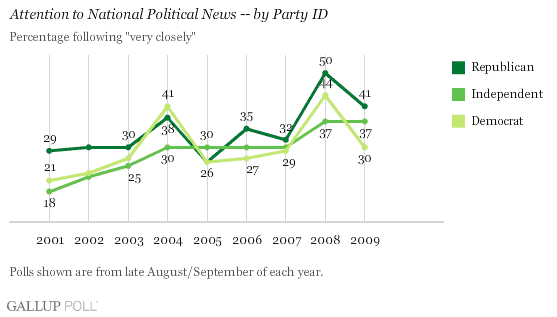
The long-term increase in very close attention to national political news is seen among all three party groups. More Democrats (with an increase in very close attention from 21% in 2001 to 30% today) and Republicans (from 29% to 41%) are now following the news this closely than was the case eight years ago; independents show a slightly larger gain (from 18% to 37%).
In addition to differences by party affiliation, Gallup finds substantial variations by gender, age, education, and household income in the percentages following the news very closely. In that men are more news-conscious than women and older Americans more so than younger adults, one of the most attentive population subgroups is men aged 50 and older. One of the least attentive is younger women
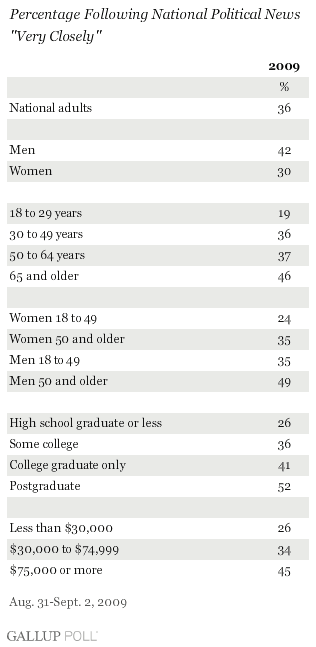
Bottom Line
Americans' consumption of political news has expanded over the past decade. The trend may reflect a greater politicization of the American public, regardless of political ideology, as attention is up among all three party groups. However, the increase since 2007 (from 30% to 36%) in the percentage following political news very closely may also stem from Barack Obama's busy legislative agenda in his first year as president.
Survey Methods
Results are based on telephone interviews with 1,026 national adults, aged 18 and older, conducted Aug. 31-Sept. 2, 2009. For results based on the total sample of national adults, one can say with 95% confidence that the maximum margin of sampling error is ±4 percentage points.
Interviews are conducted with respondents on land-line telephones (for respondents with a land-line telephone) and cellular phones (for respondents who are cell-phone only).
In addition to sampling error, question wording and practical difficulties in conducting surveys can introduce error or bias into the findings of public opinion polls.
